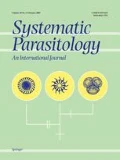Abstract
The life-cycle of Procerovum varium (Digenea: Haplorchiinae) was studied experimentally and the morphology of stages in the life-cycle has been described and illustrated. Infections with adult flukes were found in the pond heron Ardeola grayii and heavy infections with metacercariae were found, attached to the liver of the fish Oryzias melastigma (Oryziatidae) occurring in a freshwater stream situated in Visakhapatnam, India. The cercariae developing in the snail Thiara tuberculatapossessed typical haplorchiine features and were characterised by the presence of numerous cystogenous glands. Early stages of metacercarial development occurred free in the muscles of the fish intermediate host. The larvae reached the liver at 5 days post-infection, encystment commenced 2 days later and 15-day-old metacercariae were found to be infective to chicks, ducks and mice that served as suitable experimental hosts. The adult flukes obtained from natural and experimental infections showed many intraspecific variations, especially in the size and shape of the expulsor which depend on the quantity of sperm it contains. The validity of various species described in the genus and differentiated on the basis of differences in the size of the expulsor has been examined. It is concluded that only three species of the genus, namely P. varium, P. cheni and P. calderoni, are valid. "P. sisoni" of Chen (1949) is confirmed as a synonym of P. varium. P. varium is reported for the first time from India.
Similar content being viewed by others
References
Africa, C.M. (1938) Description of three trematodes of the genus Haplorchis (Heterophyidae), with notes on two other Philippine members of the genus. Philippine Journal of Science, 66, 299–307.
Africa, C.M. & Garcia, E.Y. (1935a) Heterophyid trematodes of man and dog in the Philippines with descriptions of three new species. Philippine Journal of Science, 57, 253–267.
Africa, C.M. & Garcia, E.Y. (1935b) Two more new heterophyid trematodes from the Philippines. Philippine Journal of Science, 57, 443–449.
Chen, H.T. (1949) Systematic consideration of some heterophyid trematodes in the subfamilies Haplorchinae and Stellantchasminae. Annals of Tropical Medicine and Parasitology, 43, 304–312.
Faust, E.C. & Nishigori, M. (1926) The life cycles of two new species of Heterophyidae, parasitic in mammals and birds. Journal of Parasitology, 13, 91–126.
Hsu, P.K. (1950a) Some heterophyid metacercariae belonging to the genera Haplorchis and Procerovum (Trematoda: Heterophyidae). Lingnan Science Journal, 23, 1–20.
Hsu, P.K. (1950b) A new trematode of the genus Procerovum from ducks and chickens in Canton (Trematoda: Heterophyidae.) Peking Natural History Bulletin, 19, 39–43.
Hsu, P.K. (1951) A comparative study of the early larval stages of some heterophyid trematodes belonging to the genera Haplorchis and Procerovum (Trematoda: Heterophyidae). Lingnan Science Journal, 23, 235–256.
Khalifa, R., El Naffer, M.K. & Arafa, M.S. (1977) Studies on heterophyid cercariae from Assiut Province, Egypt. I. Notes on the life cycle of Haplorchis pumilio (Looss, 1896) with a discussion on previously described species. Acta Parasitologica Polonica, 25, 26–36.
Kobayashi, H. (1942) Studies on trematodes in Hainan islands. II. Trematoda found in the intestinal tracts of dogs by experimental feeding with certain fresh and brackish water fish. Japanese Journal of Medical Sciences and Pathology, 6, 187–227.
Martin, W.E. (1958) The life histories of some Hawaiian heterophyid trematodes. Journal of Parasitology, 44, 305–323.
Nishigori, M. (1924) The life cycle of two new species of Heterophyidae, Monorchotrema taihokui and M. taichui, found in Formosa. Preliminary note. Journal of Medical Association, Formosa, 237, 567–570.
Onji, Y. & Nishio, T. (1916) A review of new intestinal flukes. Igaku Chuo Zasshi, 14, 439–442.
Onji, Y. & Nishio, T. (1924) On the intestinal trematodes. Chiba Igakukwai Zasshi. 2, 351–399.
Pearson, J.C. (1964) A revision of the subfamily Haplorchinae
Looss, (1899) (Trematoda: Heterophyidae). The Haplorchis group. Parasitology, 54, 601–676.
Pearson, J.C., & Ow-Yang, C.K. (1982) New species of Haplorchis from South East Asia, together with keys to the Haplorchis group of heterophyid trematodes of the region. Southeast Asian Journal of Tropical Medicine and Public Health, 13, 35–60.
Shen W.X. (1959) Notes on the morphology and life history of Haplorchis pumilio (Looss) (Trematoda: Heterophyidae). Acta Zoologica Sinica, 11, 470–481.
Smales, L.R. & Cribb, T.H. (1997) Helminth parasite communities of the water rat Hydromys chrysogaster, from Queensland. Wildlife Research, 24, 445–457.
Sommerville, C. (1982) The life history of Haplorchis pumilio (Looss, 1896) from cultured tilapias. Journal of Fish Diseases, 5, 223–241.
Surin, J. (1993) A description of a pleurolophocercous cercaria of Procerovum sp. from the Haplorchis group of heterophyid trematodes. Southeast Asian Journal of Tropical medicine and Public Health, 24, 692–696.
Umadevi, K. (1996) Studies on morphology, biology and surface ultrastructure of two species of haplorchine trematodes (Digenea). PhD Thesis, Andhra University India, 214 pp.
Vazquez-Colet, A. & Africa, C.M. (1940) Morphological studies on various Philippine heterophyid metacercariae with notes on the incidence, site and degree of metacercarial infection in three species of marine fish. Philippine Journal of Sciences, 72, 395–417.
Velasquez, C.C. (1973a) Observations on some heterophyids (Trematoda: Digenea) encysted in Philippine fishes. Journal of Parasitology, 59, 77–84.
Velasquez, C.C. (1973b) The life cycle of Procerovum calderoni (Africa and Garcia, 1935), Price, 1940 (Trematoda: Digenea: Heterophyidae). Journal of Parasitology, 59, 813–816.
Author information
Authors and Affiliations
Rights and permissions
About this article
Cite this article
Umadevi, K., Madhavi, R. Observations on the morphology and life-cycle of Procerovum varium (Onji & Nishio, 1916) (Trematoda: Heterophyidae). Syst Parasitol 46, 215–225 (2000). https://doi.org/10.1023/A:1006398205390
Issue Date:
DOI: https://doi.org/10.1023/A:1006398205390



